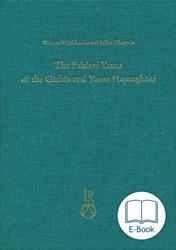The Pahlavi Yasna of the Gāthās and Yasna Haptaŋhāiti is a critical edition of the Pahlavi text, with citations of parallel passages in the Dēnkard, accompanied by a complete glossary and an introductory text-critical treatment of the text. Also provided is a parallel Avestan and Pahlavi text designed to portray the near word-by-word dependence of the gloss on the original Avestan. Owing to the very nature of the Pahlavi gloss, which itself is not a translation, no English translation is attempted.
As the title suggests the book is a study of the Pahlavi Yasna, a Middle Persian (Pahlavi) gloss on the liturgical text, the Yasna. The study is restricted to the Gāthās or Hymns of Zarathustra (Zoroaster) and to the Yasna Haptaŋhāiti, a prose text composed in the same dialect of Avestan. There are three main sections: Introduction, The Text, and Glossary. In addition there are two Appenices: I Parallel Text of the Avestan and Pahalvi Gloss; II The ašәm vohū and its Variants in the Dēnkart. The Introduction is a text-critical study of the Pahlavi Yasna which addresses the main issues of the nature of the text, its authorship and dating, and its relationship to parallels in the Dēnkard. In the presentation of the text, the position is taken that the fundamental text is a nearly word-by-word gloss on the original Avestan. That is, it is not a translation as we might understand the term. Interspersed in the gloss are miscellaneous comments inserted by later hands to illuminate certain words and passages. Appendix I is provided to portray how the glosses line up with the Avestan, ignoring the later comments. The text itself is based on the 1946 critical edition of B. N. Dhabhar given in the Pahlavi script and to which we have provided many improvements. In footnotes we have cited all the parallel passages from the Dēnkard. These reveal that there were exegetical traditions other than the official Pahlavi Yasna. Although Dhabhar's edition included a glossary, it is not up to the philological standards of current scholarship. There is deliberately no translation into English, as a running gloss of this sort does not lend itself to a coherent translation.
The contribution to the fields of Middle Persian and Zoroastrian studies is really threefold: 1) to establish a reliable text in Roman transliteration; 2) to provide an extensive glossary of all lexical items; 3) to contribute to an understanding of the nature and formation of the text. The intended readership is primarily scholars and students who have some acquaintance with Pahlavi and have an interest in the history of Zoroastrianism.
WILLIAM W. MALANDRA
Professor Emeritus, University of Minnesota
DATE/PLACE OF BIRTH: October 18, 1942 in Philadelphia, Pennsylvania, USA
DEGREES AWARDED:
B.A. in Philosophy 1964 Haverford College
(with Honors)
M.A. in Religious Studies 1966 Brown University (1965‑66)
Ph.D. in Oriental Studies 1971 University of Pennsylvania (1966‑71)
DOCTORAL DISSERTATION TITLE:
The Fravši Yašt: Introduction, Text, Translation and Commentary
ACADEMIC EXPERIENCE:
University of Minnesota, 1973-2004 (retired)
PUBLICATION:
An Introduction to Ancient Iranian Religion (Minneapolis: University of Minnesota, 1983)
Various articles and reviews; regular contributer to the Encyclopaedia Iranica
TEACHING AREAS
Sanskrit, Old Iranian, Middle Persian, Pre-Islamic civilizations of India and Iran, Zoroastrianism
PALLAN ICHAPORIA
[no response]


 Table of Contents
Table of Contents